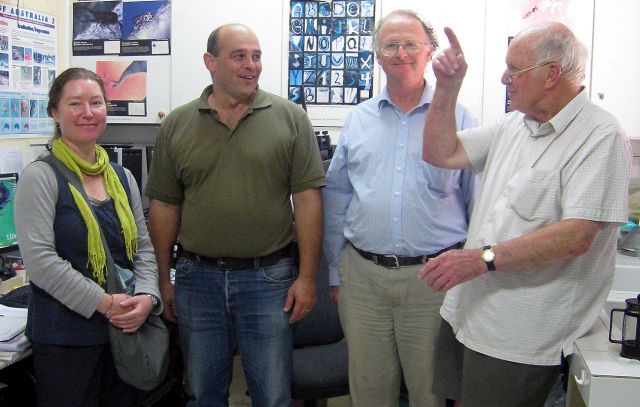Epiphyas Revision
 My name is Bobbie Hitchcock and I’m a Cooperative Research Centre for National Plant Biosecurity PhD student at the Australian National University and based at the Australian National Insect Collection in Canberra, where I’m working on a revision of the indigenous Australian moth genus Epiphyas, CRC60038.
My name is Bobbie Hitchcock and I’m a Cooperative Research Centre for National Plant Biosecurity PhD student at the Australian National University and based at the Australian National Insect Collection in Canberra, where I’m working on a revision of the indigenous Australian moth genus Epiphyas, CRC60038.
There are over 60 species in this genus and most are represented in the Australian National Insect Collection. Images of the described Epiphyas species can be viewed at Australian Moths Online.
The larvae of one species of Epiphyas, E. postvittana, became a noted pest of apples in parts of Australia during the late 1800s. This species is commonly known as the light-brown apple moth (LBAM), but the larvae of E. postvittana are widely polyphagous and can be found in other crops.
E. postvittana became established in New Zealand during the 1870s, possibly through horticultural trade, and is now also found in England, Hawaii and the United States. For information on LBAM in California please go to Todd Gilligan’s Tortricid.net website.
E. postvittana has also been reported from New Caledonia, but this has yet to be verified with the evidence that only specimens can provide! I’ve had the recent pleasure of looking for this evidence with my colleagues from Australia, New Zealand and New Caledonia.
E. postvittana belongs to a group of six similar looking but phenotypically plastic Epiphyas species known as the ‘postvittana group’ and identification of E. postvittana using morphology alone can be problematic. In order to develop tools to reliably identify the larvae and adults of E. postvittana, the within and between species variation is examined using morphology, knowledge of the genetic heritage of the genus and aspects of their biology such as host plant preference and pheromone systems.
Collections of Epiphyas species around Australia and in the Natural History Division of the British Museum have formed the basis of the morphological component of this revision. Due to the age and/or rarity of specimens in reference collections such as the ANIC, I’ve been collecting fresh larvae and adults for DNA studies. This could not have been achieved without the assistance of Bill Woods’ Project Team, CRC40024 at the Western Australian Department of Agriculture and Food.
Through Bill and his team I’ve been introduced to LBAM researchers in Australia and internationally and there have been many valuable exchanges involving the ‘postvittana group’ since. To learn more about the 2008 group meeting held in Lincoln, New Zealand, read my Travel Report.
We’ve also been able to share the joy of cold, damp, mothless nights in the South West of Western Australia during a field trip in April 2008. Since then, Ian Lacey and Alven Soopaya have trapped many E. postvittana along with the Western Australian orchard pest E. pulla and I’m currently tackling a three kg box of specimens (thanks Ian, really!) in an attempt to expand our knowledge of the distribution of Epiphyas pest species in Western Australia.

So far, I’ve collected fresh specimens for DNA-based studies of half the genus and could not have achieved this in two field seasons without specimen contributions and support from the following people: Dr Richard Newcomb, Dr Max Suckling and Leah Tooman (all HortResearch, New Zealand), Dr Cathy Young (Tasmanian Museum and Art Gallery, Hobart), Professor Peter McQuillan (University of Tasmania, Hobart), Dr Cate Paull (SARDI, Adelaide), André Messina (La Trobe University, Melbourne), Dr Marianne Horak (ANIC-CSIRO Entomology), Ted Edwards, You Ning Su, Glenn Cocking and Doug Hilton (all ANIC-CSIRO Entomology), John Dugdale (Landcare, New Zealand), The Western Australian DEC Neale Junction Reserve Survey Team led by Dr Karl Brennan, Linda Semeraro (CRCNPB and DPI-Victoria), members of the Cook (UQ, St. Lucia) and Crisp (ANU, Canberra) Lab Groups, Dr Lauri Kaila (Finnish Museum of Natural History, Helsinki), Todd Gilligan (Colorado State University, USA), Dr Mark Epstein (California Department of Food and Agriculture, USA), Professor Nick Mills (University of California, Berkeley, USA), John Langmaid and Ian Thirlwell (both Portsmouth, UK), Shane Quinn, Mark Sheargold and Mikyla Hart.
Images:
Moth hunting in New Caledonia.
From left: Bobbie Hitchcock, Christian Mille (Station de Recherche Agronomique de Pocquereux, La Foa, New Caledonia), Ted Edwards (Australian National Insect Collection) and John Dugdale (Landcare, New Zealand).
Image courtesy of Marianne Horak, October 2009.
Setting up at Newton Brothers Orchards in Manjimup, Western Australia.
From left: Stewart Learmonth (DAFWA, Manjimup), Bobbie Hitchcock and Ian Lacey (DAFWA, Kensington, Perth).
Image courtesy of Bill Woods, April 2008.
Article written by Bobbie Hitchcock

